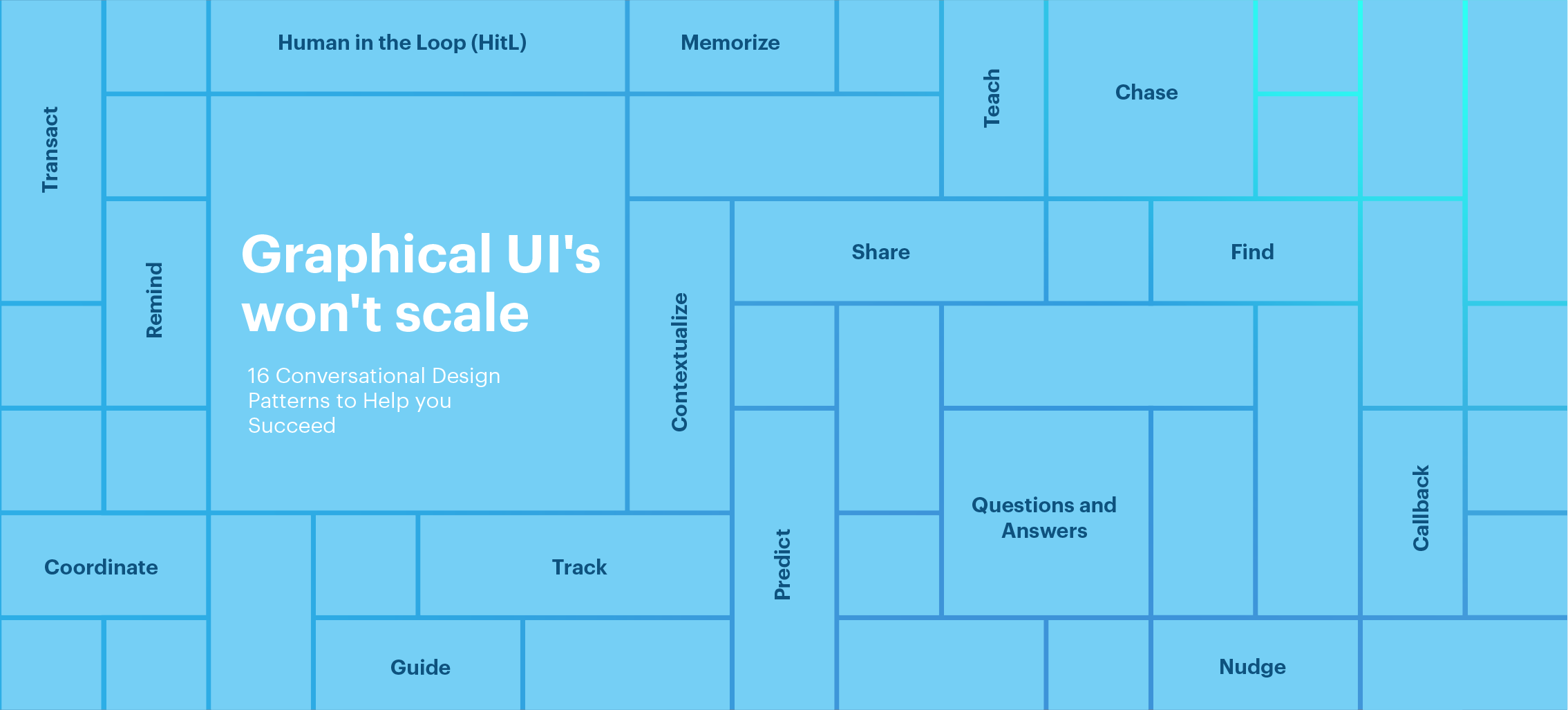
post
August 12, 2021
Conversational Design Patterns Part 1: You Will Fail Without a Design Strategy
A 4-part series sharing some of the key patterns that have emerged from successful conversational AI projects.
We’re publishing a 4-part series sharing some of the key patterns that have emerged from successful projects. Follow us on social media (LinkedIn, Twitter, Facebook, or Instagram) to stay tuned as this series comes out.
Why conversation?
Leaders are turning to conversational AI to provide a unified interface that actually scales. Salesforce didn’t just acquire Slack, their CEO has openly admitted that they are rebuilding their entire organization around Slack. Microsoft is making a similar bet with Teams: that an integrated communication platform and a unifying conversational interface—one bot that connects to everything—will benefit customers, employees, and organizations in big ways.
There have been attempts to scale GUIs, like Sharepoint, but they ultimately revealed the hard truth that a UI with a hundred tabs designed by as many people is even worse to navigate than it sounds. No doubt, one of the biggest reasons Microsoft is moving from Sharepoint to Teams is the scalability of a conversational interface that’s connected to everything. Customers and employees alike can interact with a company through one portal that ties together and obscures the sausage factory behind the scenes.
Due to the inherently complex nature of the tasks, the lack of maturity in the tools, and the difficulty in finding truly experienced people to build and run them, creating Better-than-Human experiences is extremely difficult to do, or, as Gartner calls it, “insanely hard.” Over the years we’ve watched many successful and failed implementations (including some of our own). Automating chatbots on websites, phone, SMS, WhatsApp, Slack, Alexa, Google Home, and other platforms, we formulated our point of view on how to build and manage primitive conversational applications. Patterns began to emerge from successful projects. We began studying those success stories to see how they compared to others.
The data and best practices that helped us with this conversational design pattern series have been gathered from our experience with over the course of 2,000,000+ hours of testing with over 30,000,000 people participating in workflows across 10,000+ conversational applications. It’s important to keep in mind that to succeed with conversational AI, you’ll also need processes, people, tools, architecture and to go along with design that works in a coordinated way. Robb Wilson, founder of OneReach.ai has been writing a book with resources, perspective, and data for all of the parts of the strategy for succeeding with conversational AI – sign up on our homepage to stay notified about the book; Age Of Invisible Machines.
Conversation is the most natural way for humans to exchange ideas, connect with one another, and accomplish shared goals. Nobody really knows when the first conversation took place, but it was likely very practical in nature: a warning about danger, a plea for help, the sharing of a useful discovery.
Keeping practical conversations at the core of your strategy can help keep your design on-track while also helping you avoid the most common failure point: end-user adoption. All your efforts are for nothing if people don’t use what you build.
With conversational AI, users aren’t comparing their experience with your solution to experiences with other similar technologies, they’re comparing them to experiences they have in conversation with other humans. But the designer’s job isn’t to mimic human interactions, it’s to go far beyond human interactions.
When our earliest ancestors began using rocks to smash things (tree fruit, perhaps) one of them realized that a rock could also smash things that a fist could not (tree nuts?). This was an early form of design—of humans using technology to extend their capabilities—and it perfectly encapsulates the type of thinking that should be applied to the design of intelligent ecosystems of digital workers. We don’t want to use this rock to do what humans can already do, we want to use it to achieve things humans alone cannot.
For this reason, a sound design strategy for conversational AI within an intelligent ecosystem of digital workers relies on service patterns that are practical and hew to similar interactions with another human while also seeking opportunities to evolve processes and create truly innovative automations.
Key Patterns for Successful Conversational Design
Before you touch any technology, you need to envision the experience that you want to create. To avoid creating bad experiences, we studied highly-rated experiences and noted patterns that lead to good experiences. Keeping these patterns in mind as you build the framework of your ecosystem—design automation flows and strategizing their deployment—can help create an ecosystem of real service.
In part 2, we’ll take a look at the patterns Q&A, Find, Contextualize, Memorize, Guide, and Remind. You’ll learn what these patterns are and how to use them in conversation design. Follow us on social media (LinkedIn, Twitter, Facebook, or Instagram) to stay tuned as this series comes out!
Stay up to date
Latest Articles




